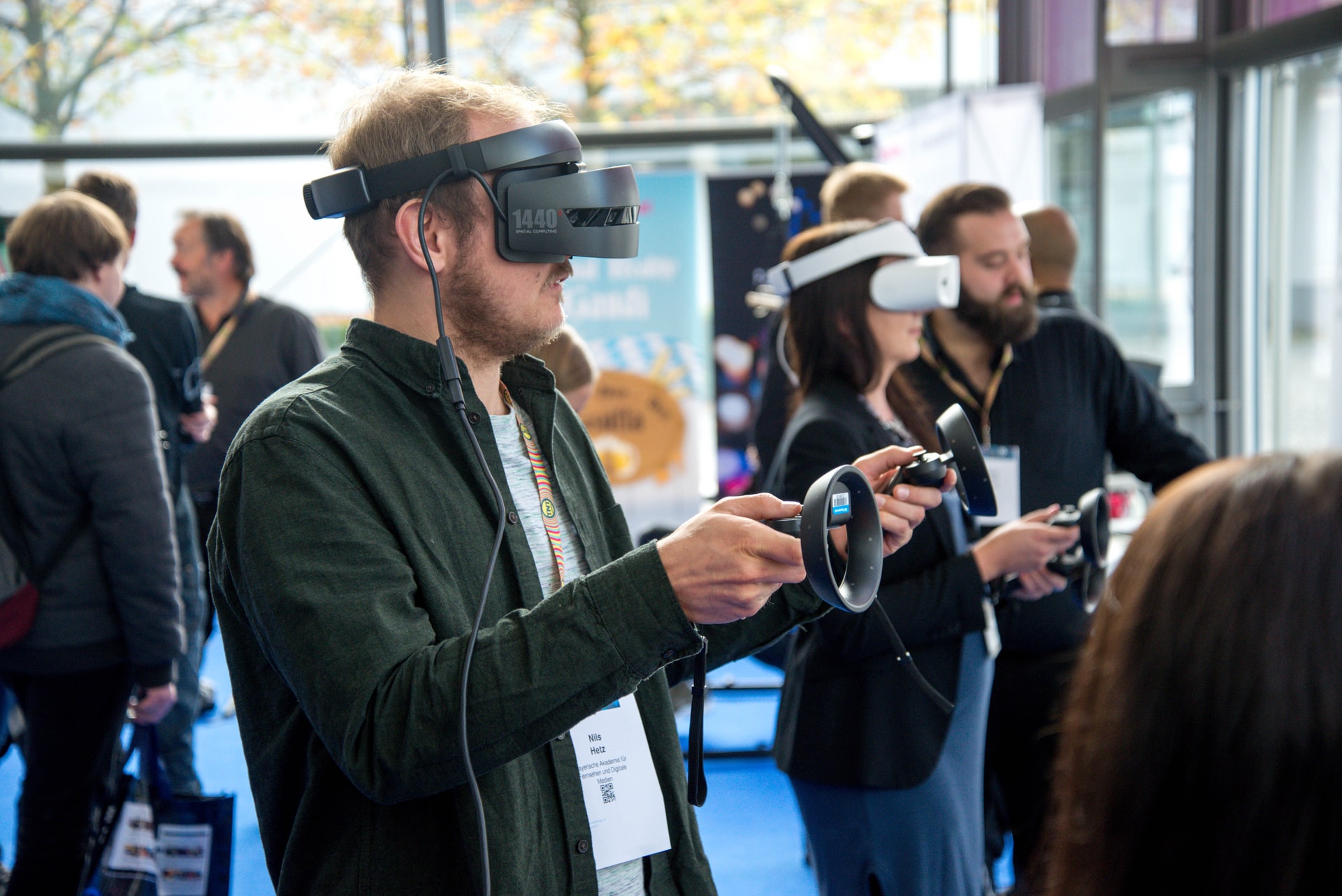Unless you’ve been on a digital detox for the past few months, you’ve undoubtedly heard the latest buzzword bouncing around: the metaverse.
And, if you’re an enterprise leader, you probably dismissed it just as soon as you heard it — but that’s probably a mistake.
The so-called metaverse may be a significant opportunity for enterprise leaders that get their head around it first. So consider this your wake-up call.
But before I get into why it represents such a potential opportunity, we need to start with what it is in the first place. That’s not quite as simple as you might think, as evidenced by the wide-ranging (and sometimes baffling) definitions thrown around in recent earnings calls.
While countless definitions are floating around, futurist Devin Liddell offers the one that I think sums up its potential for the enterprise best: “The metaverse is the convergence of the digital and the physical into a new experience of the Internet.”
I like this definition because it brings it down to earth and makes it feel a bit less futuristic and fantastical. The reality is that almost everything necessary to realize the potential of the metaverse not only already exists but is in full production with proven results.
This view of the metaverse as essentially the natural evolution of the Internet is why it has such great potential for the enterprise. This future hasn’t gone unnoticed. Not only by Facebook, er, Meta, but by the king of enterprise productivity apps: Microsoft.

The Enterprise Potential
While changing its name from Facebook to Meta caused the world to pause and pay attention to the metaverse, an announcement at Microsoft’s Ignite conference was the big signal of the metaverse’s relevance to the enterprise.
Earlier this year, the company announced what it calls Mesh that “enables augmented reality and virtual reality experiences across a variety of goggles, including Microsoft’s own HoloLens,” as Bloomberg reported. But at Ignite, the company announced that this underlying technology would be incorporated into Teams to enable digital avatars and allow enterprises to create immersive digital spaces where company employees can meet.
As Bloomberg reported, Accenture launched a virtual headquarters to onboard new employees using Microsoft’s new platform. The company further announced Dynamics 365 Connect Spaces, which lets people (employees and customers) move around and interact with digital representations of everything from factory floors to retail spaces.
But Meta also sees the metaverse as an enterprise play.
It announced an app called Horizon Workrooms. The app, accessed using the company’s Oculus Quest 2 virtual reality headset, transforms employees into cartoon bobbleheads that float in a virtual office. Likewise, the company is also doubling down on its Meta Workplace product to “go after people who have never had IT before,” as Meta Workplace Vice President Julien Codorniou told Protocol — and it sees things like the metaverse and augmented reality as key channels to this approach.
While it’s easy to dismiss it as hype and hyperbole, when players as big as Microsoft, Meta, and Accenture are investing this much in an enterprise version of the metaverse, you should pay attention. But the big question remains: why?
The answer lies in its potential to help enterprises deal with some of their most pressing issues: competing for talent, fighting burnout, and staying ahead of digital experience expectations.
A Generational Issue
One of the reasons that enterprise leaders are likely to dismiss the metaverse is that its initial incarnations seem to revolve around gaming and fadish-sounding marketing efforts. And while it is true that staking a marketing claim in the consumer-oriented metaverse platforms is worth considering, that’s not where its true enterprise potential lies.
For enterprise leaders, the reason the metaverse will be vital to you is simple: it’s where your employees will want to work and collaborate.
In an article for FastCompany, Nick Pringle, SVP and Executive Creative Director at R/GA London, explained that it’s all about attracting Generation Z, which is just entering the workforce, and Gen Alpha, that will be entering it in the next decade. “Detractors see the metaverse as a pandemic fad, wrapping it up with the current NFT bubble or reducing it to Zuck’s dystopian corporate landscape,” he said. “This misses the bigger behavior change that is happening among Gen Alpha.”
 He explains that when you look at how these youngest generations interact socially — on Fortnite, Roblox, or even when using Pokemon Go, arguably the current precursors to what will become the full-fledged metaverse of the future — they stroll virtual or augmented spaces comfortably. “When you watch how they play, it becomes clear that the metaverse is more than a buzzword,” he said. “While millennials relentlessly scroll feeds, Alphas and Zoomers increasingly stroll virtual spaces with their friends.”
He explains that when you look at how these youngest generations interact socially — on Fortnite, Roblox, or even when using Pokemon Go, arguably the current precursors to what will become the full-fledged metaverse of the future — they stroll virtual or augmented spaces comfortably. “When you watch how they play, it becomes clear that the metaverse is more than a buzzword,” he said. “While millennials relentlessly scroll feeds, Alphas and Zoomers increasingly stroll virtual spaces with their friends.”
And it doesn’t take a huge leap of faith to realize that if this is how they interact with their friends, it’s how they’re going to want to interact and collaborate with their coworkers. So, competing for their talent will mean delivering the type of collaborative work environments they want — and that’s going to mean the metaverse.
That’s why when you break it all down — at least from an enterprise perspective — the metaverse is really all about the future of work. And it’s why its impact will extend far beyond Gens Z and Alpha.
It’s All About the Future of Work
In many ways, the current fervor over the metaverse is just an extension of mental shifts that have been underway for some time.
Even before the pandemic, the traditional concepts of where, when, and how to work were already under assault. “Younger generations of workers have been criticized for opting out of a cycle of breaking themselves to make their careers, but they’re right—productivity and success shouldn’t require giving up your personal life, family, or daylight hours,” wrote Nicole Kobie in Wired. “Technology should help us work less, and smart managers will understand that workplace wellness has nothing to do with yoga and mindfulness apps and everything to do with respecting the right to such balance.”
The pandemic, of course, accelerated this shift.
Throw in the great resignation and an ever-tightening labor market (particularly for tech-savvy knowledge workers), and enterprises are finding themselves in an all-out war for talent. That means that the talent is setting the rules.
Increasingly, today’s worker wants a way to be productive and engage with their coworkers socially and collaboratively — and to do it without becoming a Zoom Zombie. The metaverse will likely be how they will want to do that.
They probably just won’t call it the metaverse. “It will not be known, by the people who inhabit its sprawling, distinct, yet-to-be determined environments, as ‘the metaverse,’” said John Herman writing for The New York Times. “If we’re really doing our jobs in virtual offices, we’ll just call it work.”
And it’s already starting to happen. The technology is (mostly) already there, and as people become more open to new ways of working, demand will continue to increase. “Without doubt new technologies like 3-D environments, AR, and VR are going to transform the way we interact and live our lives,” explained Leanne Wood, Chief HR Officer at Vodafone. “I suspect that, like lots of big trend predictions, the reality will take a slightly different form to the one that made the headlines, but the impact of technology on the world of work is going to continue to be significant.”
All of this leads to the big question: how should enterprise leaders respond to this emerging shift?
From the Metaverse to the Multiverse
While I’m clearly bullish on the idea of the metaverse in the enterprise, these are early days. Many battles are afoot to stake claims to this “new Internet.”
This early stage’s uncertainty will make it challenging to understand how to proceed amid contrasting visions for this future.
Meta, for instance, wants to build — and own — the metaverse. Others, like Microsoft, don’t envision a single metaverse, per se, as much as an interconnected, interoperating ecosystem of virtual environments (using both augmented and virtual reality) into what it is calling the multiverse.
 “There’s a world out there that thinks there will be a metaverse, and everyone will live in ‘my’ metaverse. That, to me, is a dystopian view of the future,” Alex Kipman, technical fellow for AI and Mixed Reality at Microsoft, told FastCompany. “I subscribe to a multiverse. Every website today is a metaverse tomorrow. What makes the Internet interesting—opposed to [old platforms like] AOL and CompuServe—is linking between websites.”
“There’s a world out there that thinks there will be a metaverse, and everyone will live in ‘my’ metaverse. That, to me, is a dystopian view of the future,” Alex Kipman, technical fellow for AI and Mixed Reality at Microsoft, told FastCompany. “I subscribe to a multiverse. Every website today is a metaverse tomorrow. What makes the Internet interesting—opposed to [old platforms like] AOL and CompuServe—is linking between websites.”
The company’s ambitions seem to be less about owning one metaverse and more about powering a world full of them.
As FastCompany reported, “Rather than rule its own metaverse as Meta/Facebook aspires to, Microsoft sees its role with Mesh in providing the foundational glue that helps hold a multiverse of worlds together.”
If the past is prologue, it would seem that this world of multiple interconnected metaverses appears to be the most likely outcome — and one that will make it an even more complex journey for enterprise leaders.
But as with all previous shifts, while it represents a challenge for all, it’s also an opportunity for those that move first and fastest.
The End of the World or The Future?
Of course, not everyone is so enamored with the prospect of a virtual world that recreates all the angst and drama of the real world — not to mention the industrial age office setting.
“It’s absurd but telling that the inspiration for the metaverse was meant as satire,” writes Ian Bogost in The Atlantic’s article The Metaverse is Bad, referring to the 1992 book, Snow Crash, where the concept of the metaverse originated.
“The book’s title refers to a digital drug for denizens of the metaverse, with harmful neurological effects that extend outside it,” he continues. “That danger hasn’t survived the metaverse’s translation into contemporary technological fantasy. Instead, the concept appeals to tech magnates because it connects the rather prosaic reality of technologized consumer attention to a science-fictional dream of escape.”
And he’s not alone in his fear that this is a potential future gone awry. “Never in my life have I gone to an office and thought, ‘If only this could become an intense VR application!’” writes Sarah Jones in her mildly titled essay for New York Magazine, The Metaverse Looks Like Hell. “Will the Workrooms app catch on? For our sake, I hope it does not. Seems a lot easier to just let people work from home and leave them alone.”
These sentiments point to the minefield that the metaverse represents for enterprise leaders.
There will be immense pressure to adopt it in some form, but you will always be one small step away from creating a digital experience that repels your team and customers in catastrophic ways. Still, the risks of turning a blind eye to this future are more significant.
The only real answer is recognizing its potential and moving quickly so that you have time to experiment, test, and iterate. Crafting the right metaverse-powered digital experience for your employees, customers, and partners is going to be one of the only ways forward.
Just step carefully.
© 2021, Intellyx, LLC. Intellyx publishes the weekly Cortex and Brain Candy newsletters, and advises business leaders and technology vendors on their digital transformation strategies. Intellyx retains editorial control over the content of this document. At the time of writing, none of the companies mentioned in this article are Intellyx customers.



